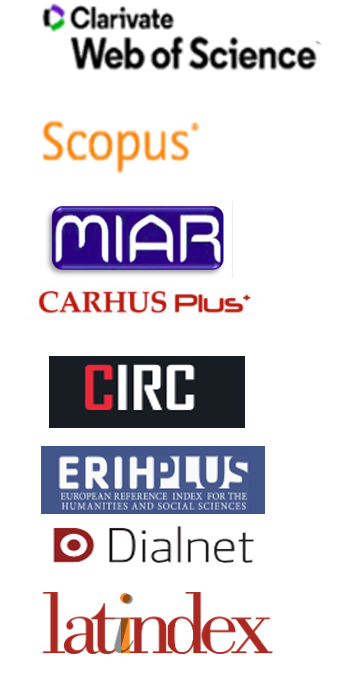El Retoque en la Fotografía Científica – La Colección de Negativos de Vidrio del Museo de Historia Natural e de la Ciencia – Universidad de Porto
Abstract
Este trabajo presenta una parte del proyecto de investigación sobre el retoque de negativos fotográficos de gelatina y sales de plata sobre placas de vidrio, intenciones, impacto de la práctica en la imagen y objeto y su estado de conservación. Éste es un estudio de caso del uso de las técnicas de retoque en una colección científica, de aquél que fue el Instituto de Antropología Dr. Mendes Correia, del Museo de la Historia Natural y de la Ciencia de la Universidad de Porto (MHNC-UP). En la fotografía científica es necesario un registro riguroso, la representación de la verdad, lo que diferencia este tipo de colección fotográfica de otras. Cualquier alteración, como el retoque, debe tener, por lo tanto, poca o ninguna intención estética. Se identificaron negativos retocados en esta colección científica y académica, lo que permite que se compruebe el propósito de su uso y la necesidad de su preservación.
Downloads
References
CORREIA, A. A. M. (1916). “Sobre alguns objectos protoistóricos e lusitano-romanos especialmente de Alpiarça e Silvã”. Lisboa. O Archeologo Português XXI: 331-337.
CORREIA, A. A. M. (1940). “Nota sobre a fotografia aplicada à Antropologia em Portugal”. In Comemoração do Centenário da Fotografia. Sep. Memórias da Academia das Ciências de Lisboa, classe Ciências, Carvalho, A. (coord.). Lisboa: Academia das Ciências de Lisboa, 123-125.
COSTA, F. M; JARDIM, M. E. (coord.). (2014). 100 anos de fotografia científica em Portugal (1839-1939). Imagens e instrumentos. Lisboa: Edições 70.
FRIZOT, M. (dir.) (1995). Nouvelle Histoire de la Photographie. Paris: Ed. Bordas - Adam Biro.
HANNAVY, J. (Ed.). (2007). Encyclopedia of Nineteenth-Century Photography. New York: Routledge.
HERRERA GARRIDO, R. (2011).“Técnicas de retoque de negativos fotográficos historia y conservación”. Pátina, 16: 125-136.http://revista-patina.escrbc.com/numero/16. [Accessed: 03/05/2016].
MATOS, P. (2012). “Mendes Correia e a Escola de Antropologia do Porto: Contribuição para o estudo das relações entre antropologia, nacionalismo e colonialismo (de finais do século XIX aos finais da década de 50 do século XX)”. Thesis. Lisbon: Instituto de Ciências Sociais da Universidade de Lisboa.http://hdl.handle.net/10451/7831. [Accessed 02-11-2016].
MATOS, P. F. (2014). “A fotografia na obra de Mendes Correia (1 888-19ó0): Modos de representar, diferenciar e classificar da Antropologia Colonial”. In O Império da Visão – Fotografia no contexto colonial Português (1860-1960). Vicente, F. L. (org.).Lisboa: Edições 70, 45-66.
NUNES, M. F. (2005). “Arqueologia de uma prática científica em Portugal – uma história da fotografia”. História. III - 6: 169-183. http://ler.letras.up.pt/uploads/ficheiros/3382.pdf. [Accessed 02-11-2016].
PEDERSEN, K. B.; Kejser, U. B.; Christensen, M. C. (2005). Coatings on Black-and-white Glass Plates and Films. In C. McCabe, Coatings on Photographs: Materials, Techniques, and Conservation (pp. 108-131). American Institute for Conservation of Histooric and Artistic Works.
PEREIRA, C. (2010). “O retoque do negativo fotográfico: estudo de uma colecção do Arquivo Fotográfico da Câmara Municipal de Lisboa”. Estudos de Conservação e Restauro, 2: 38-57. http://revistas.rcaap.pt/ecr/article/view/3153/2542. [Accessed: 03/5/2016].
PEREIRA, C. (2016). “Materials and techniques for retouching glass plate photographic negatives in the beginning of the 20th century”. In III International Meeting on Retouching of Cultural Heritage: RECH3. Porto. Escola Artística e Profissional Árvore, 65-72 https://issuu.com/ineditar/docs/postprints_rech3 [Accessed: 03/5/2016].
PERES, I. V. (2013). “Fotografia científica em Portugal, das origens ao séc. XX: investigação e ensino em química e instrumentação”, thesis. Lisbon: Faculdade de Belas Artes da Universidade de Lisboa. http://hdl.handle.net/10451/8692. [Accessed: 03/10/2016].
SCHRIEVER, J. B. (1909). Complete self-instructing library of practical photography Vol. 1-10 Scranton: American School of Art and Photography. https://archive.org/details/completeselfinst10schriala. [Accessed: 10/6/2016]
SILVA, A. S. (1997).“O Porto em busca da Renascença (1880-1911)”. Penélope: Género, discurso e guerra, 17: 51-69.
VOGEL, H. W. (1870). Lehrbuch der Photographie - Theorie, Praxis und Kunst der Photographie. Berlin: Louis Gerschel Verlagsbuchhandlung. https://archive.org/details/lehrbuchderphoto00voge. [Accessed: 03/05/2016].
- Copyright and intellectual property belongs to author. Author guarantees editing and publishing rights to Ge-Conservación Journal, under a Creative Commons Attribution License. This license allows others to share the work with authorship and the original source of publication acknowledgement.
- Articles can be used for scientific and educational purposes but never for commercial use, being sanctioned by law.
- The whole content of the article is author’s responsibility.
- Ge-Conservación Journal and authors may establish additional agreements for non-exclusive distribution of the work version published at the Journal (for example, on institutional repositories or on a book) with acknowledgment of the original publication on this Journal.
- Author is allowed and encouraged to disseminate his works electronically (for example, on institutional repositories or on its own website) after being published on Ge-Conservación Journal. This will contribute for fruitful interchanges as also for wider and earlier citations of the author’s works.
- Author’s personal data will only be used for the Journal purposes and will not be given to others.









